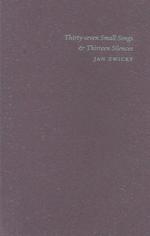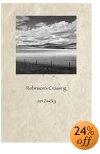Thirty-Seven Small Songs & Thirteen Silences

by Jan Zwicky
80 pages,
ISBN: 1554470013
Robinson's Crossing

by Jan Zwicky
84 pages,
ISBN: 1894078373
Post Your Opinion | | To Know The Pine
by Abou Farman
No surprise, given her day job, that Jan Zwicky is a thinking poet. As a philosopher, she has dedicated a good deal of effort to nudging the discipline into a more poetic, rather than strictly analytic, style. It's an endeavour given as much to glimpsing truth via the refracting powers of metaphor as to grasping the precise outlines of things through a narrow focus on concepts; hers is a philosophy, in short, that would recognize "the necessity of both love and wisdom." She has championed poetry's metaphor-making essence while arguing in favor of metaphors as a mode of thought that brings wisdom. Ours would be a wiser world, Zwicky seems to believe, if more philosophers were poets. But what kind of a world would it be if more poets were philosophers?
Her own trajectory as a philosopher poet-from her first major book of poems, Songs For Relinquishing the Earth through last year's Robinson's Crossing, to her new collection, Thirty Seven Small Songs & Thirteen Silences-traces a movement from the culture of exegesis to zen minimalism, from Brahms and Kant to Basho and "a sound like rain". It's a poetry of big thoughts and big music distilled into little glimpses and a bit of stillness. In the end, though, there is not enough of the latter.
The impulse towards purification is there in Robinson's Crossing, when in some short poems she uses the sensory world to flash a quick light on what she calls the "unwordedness/ of beauty". In general, however, the volume is dominated by long poems of personal history and collective memory. She yearns not for the past itself, but for the past to yield knowledge or meaning, help us determine what we should make of the present. Instead, she finds herself having to value puzzles and ambiguities: found photographs of pioneers hint at something but don't reveal identities; significant geographies turn into ditches; multinationals spread genetically modified seeds around silos adorned with "flowing nineteenth-century script." All we have are signs without a code. Events fade in "the silence in between the ticking" and while we mark time, everything happens between the gradations. Behind our facts and myths and the questions asked of grandma, lie a "different set of stories/ we don't know how to tell."
Written almost entirely in the past tense, Robinson's Crossing honors "not memory, but/ perhaps what memory's for." And what is memory for? For remembering, of course.
. . . the more stuff
gets consigned to the museum
or the dump, the more the things
I find myself remembering
are sweet.
Memory as fetish has been a staple of English poetry since Wordsworth. In the secular absence of redemption, the inadequacy of mythology, and the failure of social revolution, Wordsworth turned to personal memory for solace, "a dwelling-place/for all sweet sounds and harmonies" that you might drag back with you from visits to Tintern Abbey. Or Robinson's Crossing. In this age, with the past so contested and memory unstable, Zwicky must make a virtue out of necessity: not knowing is not such a bad thing, really; it's an opportunity. If memory is never more than just an attempt at remembering, it is at least an occasion for contemplation, a chance to take the imagination on a good day's outing.
It works in the stronger poems ("Nostalgia", "Track", "Robinson's Crossing", some of the "History" poems) though on the whole it begins to wear thin. There are too many places that aren't quite reached, stories that can't be told, meanings that get "the night shift" (and in between one must duck past a trickle of wet odes to bees, soup and metaphysics, which seem to dip weakly into the Danubian swirl that stirs the works of Simic, Szymborska, and Herbert).
Hauling the past through Robinson's Crossing, Zwicky is naturally more obsessed with the belongings she drags along than with what she encounters on the way. In Thirty-seven Small Songs and Thirteen Silences she sheds much of that weight, relinquishing memory for experience. No verb takes the past tense and sometimes, as though these were translations from the Japanese, there is no tense at all. The collection is simply the present declaring itself. "The sea is lonely today" and "This morning, violets/ in the clearing by the porch." History and marked time replaced by timelessness, "the now/ that's everywhere and all there is/ of time." With this temporality comes a lightness in Zwicky's step. Rather than reaching and not arriving, and having to be philosophical about it all, Zwicky hops out, shouting, "Hey cicadas: it's morning again!" She starts another poem with, "So: we are alive!", a bold opening gambit, almost trembling off the page with potential, followed by the simple tokens that make this miracle: "bread", "talk" and "coffee" and, at the quick and beautifully measured end, "ash tress leaping into the astonished sky." The astonishment of course is ours, human consciousness' plain and endless surprise at being. She has obviously decided to travel with little but what is already around her, offered to her by the world at any given moment. That's all any of us has really, so we better take delight in it. It's the mystic's insight and, ironically, the weakness of this book: in all but a few crisp poems there is too great a sense of obligation to the idea.
"E]ven travelling light," Zwicky admits, "life's/pulled from its shelves, turned out of drawers." Evoking a common disquiet, she begins bluntly: "Packing and anxiety". At the same time, she claims she's calm, a feeling she attributes to the effects of the "orange light" and the "long grass gathered in the silky dew." The sensory world pacifies the intellectual one. Or at least that's the idea. Yet it's not clear how calmness and anxiety can coexist simultaneously, and neither the postcard dusk of "orange light" nor the limp construction "silky dew" seem vital enough to transform psychological anxiety into existential serenity. The gesture towards the phenomenal feels false because the light and the long grass follow the calm, instead of generating it. Here she is, transported by music:
Washing dishes after supper,
listening to the radio,
hands-raised, mid-air,
the soap suds dripping
Vermeer might have painted the image, circa 1950. The language could be a little stronger and tighter but the momentary loss of self-awareness is caught perfectly in the upwards, almost devout, position of the hands and the soap sliding down the skin, the lifting of the spirit and the downward tug of physics. But then she follows with the second stanza:
What are you, music -
that in entering
undoes us? And undoing,
makes us whole.
Why the explanation? Are not the undoing and the making whole again already part of the image, part of what the reader's imagination folds out of the image unaided? This happens over and over. Instead of trusting the reader to understand concepts like emptiness or absence from the image of, say, "the windrows and the stubble" on a withered field in August, she hands them to us packaged in unnecessary exegetical wrappings such as "everything/ alight with emptiness". Uninspired language ("O river of cedar shadow/ chinchilla skin of the night"), bad rhythm ("The house of childhood has/ white siding and red/ window frames . . . ), dull language coupled with bad rhythm ("Down the dirt lane you have been/ afraid to walk, back to the garden in its/ loveliness . . .") are bothersome formal problems, but the more far-reaching issue is this conflict between thing and idea, image and metaphor.
At its root, it's an old problem, dense with histories of religion and art. The coupling of poem and painting in the Greek and then Roman doctrines of Ut Pictura Poesis recognized the intimacy of text and image, not as a commentary of one on the other, but as different styles of conveying the core impulse towards art. Poetry was "speaking pictures" and pictures were "mute poems". They both had the iconic power of something inanimate to animate us. It was just this power that Plato mistrusted in poets and the Old Testament God deemed unacceptable competition in the golden calf, while Byzantium fought three wars over images, finally dividing the Eastern from the Western church. The Western church, worried about the idolatrous confusion of an image for the thing itself, found a solution in permitting pictures for instructional purposes, to aid in conveying the lessons of Christianity. Images were transformed from icons-self-sufficient, devotional-into metaphors, tools to explain, sermonize. This became the predominant frame of Western art and part of its intellectual development. In English poetry, as Robert Hass has remarked, images were absent until the 20th century. Even then, Pound and Williams and the imagists steered close to the philosophical and psychological. Pound's definition of image, after all, emphasized "an intellectual and emotional complex."
Despite her eastward orientation, Zwicky's too embedded in this tradition to trust images alone. Writing on the subject in a previous book, Wisdom and Metaphor, she calls a metaphor a "meta-image". That perhaps is where the trouble lies, for a meta-image is no image at all. A metaphor has the imaginative power to transform, let aspects of a thing echo out in new ways. It opens up a world beyond the thing itself, reaching out to some other thing, but it's also limited by that coupling, the possible meanings bouncing between a set of parameters. An image opens the world up through itself; it is more self-contained. It strikes us with its presence, like a spirit bursting out of a stone, thrusting upon us an "ontological communion", as Hans Georg Gadamer called it, a direct understanding. An image loses its vital force, its presence, as soon as it goes "meta". Just as an explanation of magic kills the magic, an explanation of the image kills the image. Of the Japanese master poets-whose influence on Zwicky is direct ("yellow leaves at first light", from the closing "Silence" of the book, is a Canadian autumnal rendition of Buson's death-bed poem)-none interpret. They have an interpretive relationship to the world, of course, but that's not how they write. Making a good image requires an effort to render the commentary less visible and the recognition more immediate, while making a good metaphor demands the opposite style. Each has its advantage, but in contest they subtract from a poem.
When, reflecting on a night of loneliness, Zwicky writes about the moon staring back at her, the image is good enough to sit with for a while, to let seep through our own pores. But quickly she imposes her metaphorized parameters: "What is this heart? / Why do you wander by the autumn river? / Why won't you come home?" That existential loneliness is reigned in by heart and home. Love, grief, sadness, the lost self and other psychological abstractions intrude to metaphorise the image and weaken it. "A wind fled through the yard/ and now the rain comes after.// The end of drought - " So why continue with: "is this why it comforts me?" What is meant to be immediacy of sensation and depth of spirit, feels distant and full of thinking.
"To know the pine," Basho wrote a long time ago, "go to the pine". Zwicky, I feel, has not gone close enough to the pine, but being sensitive, intelligent and well-read, she knows what it might feel like to go there. She is not idolatrous enough and that could make the difference between a philosopher poet's world and a poet philosopher's world. ò
|